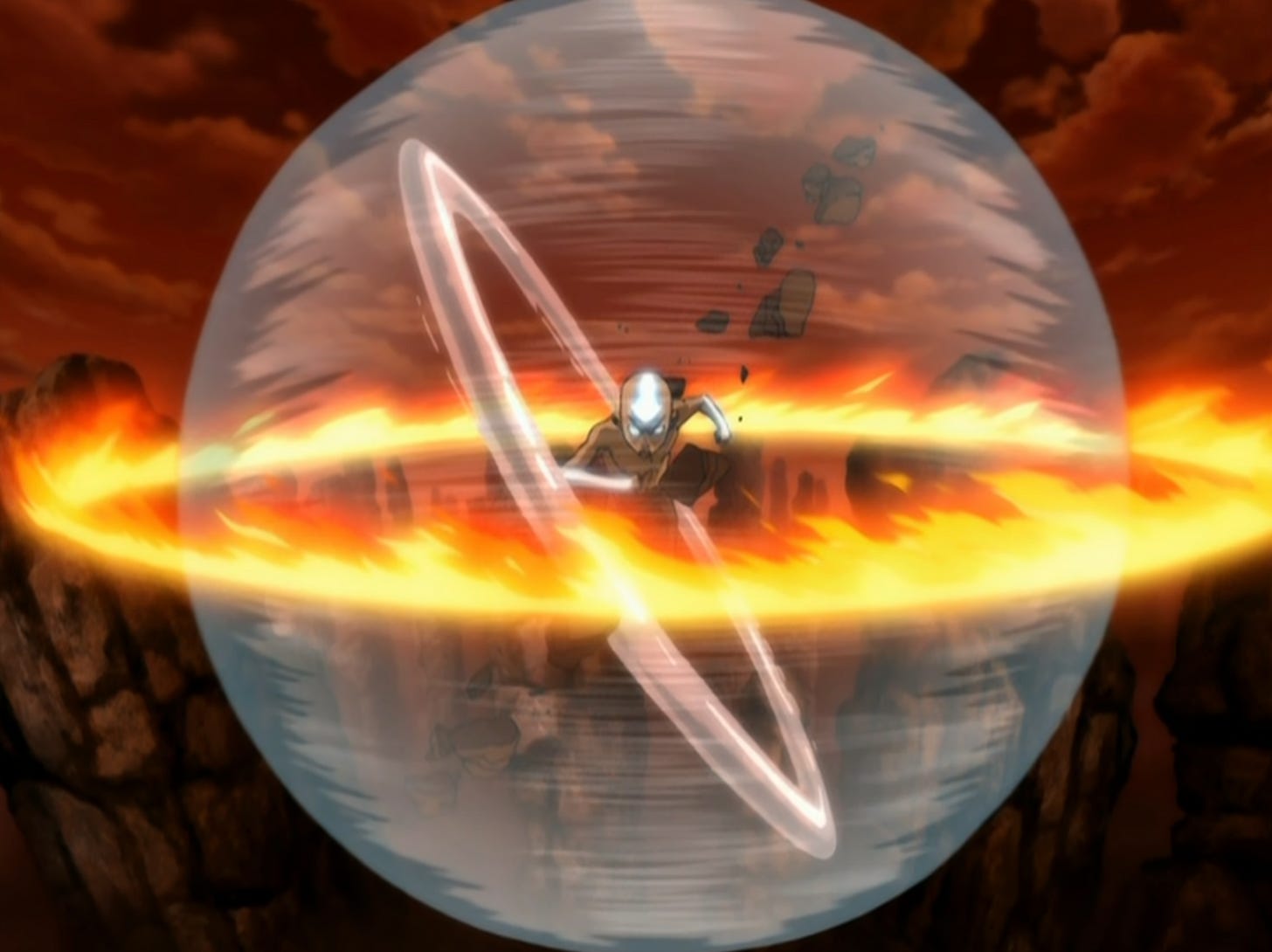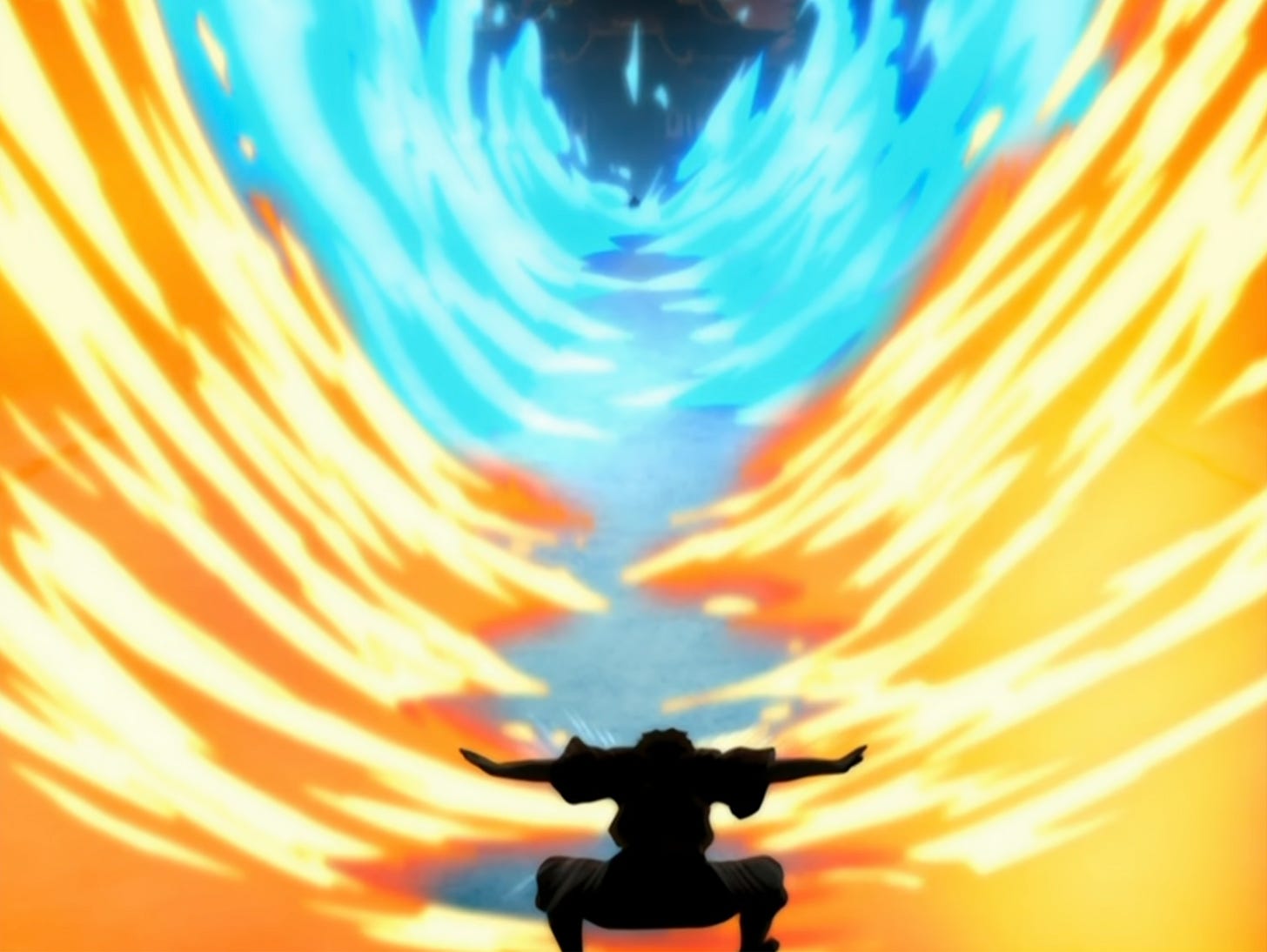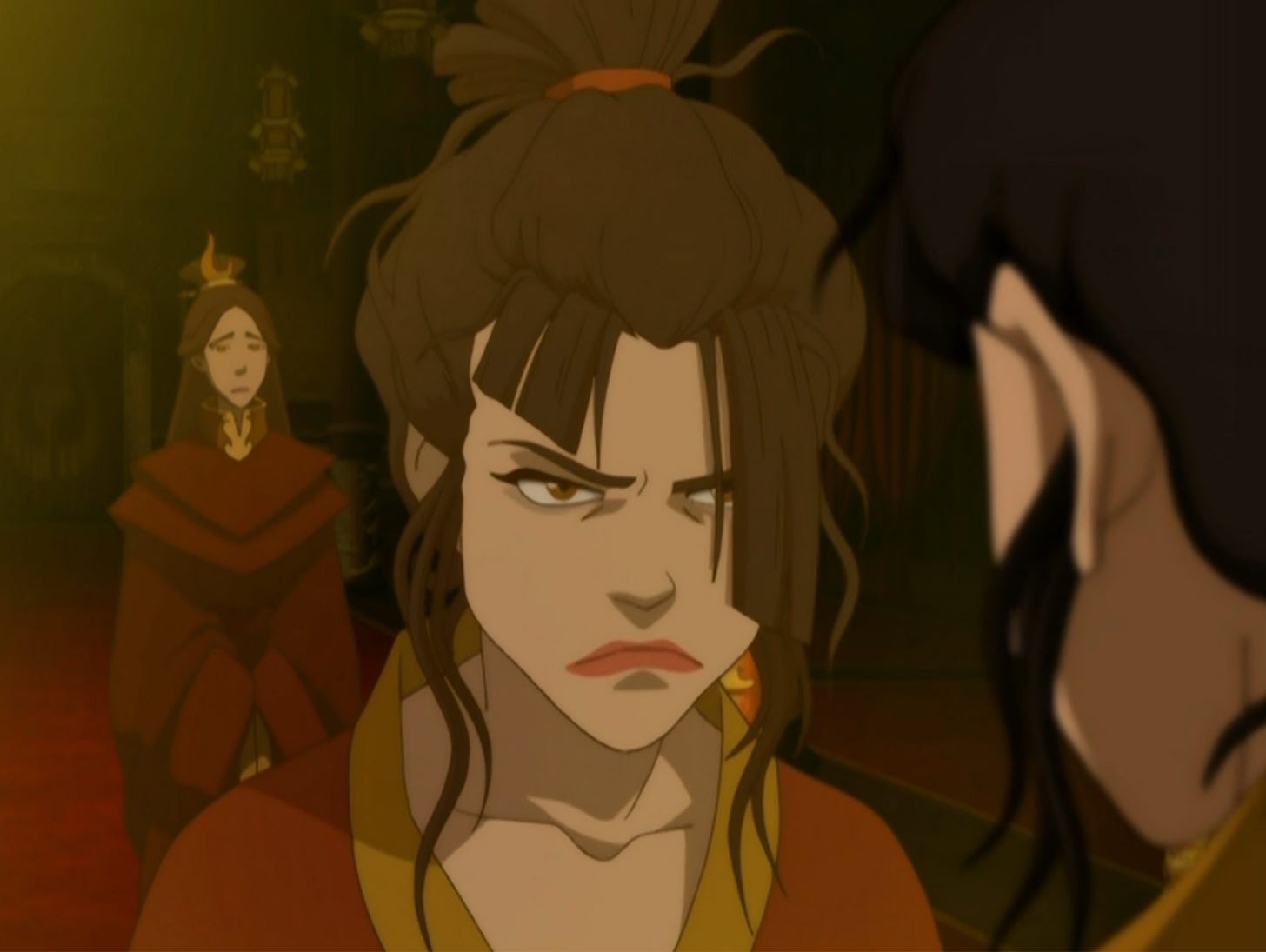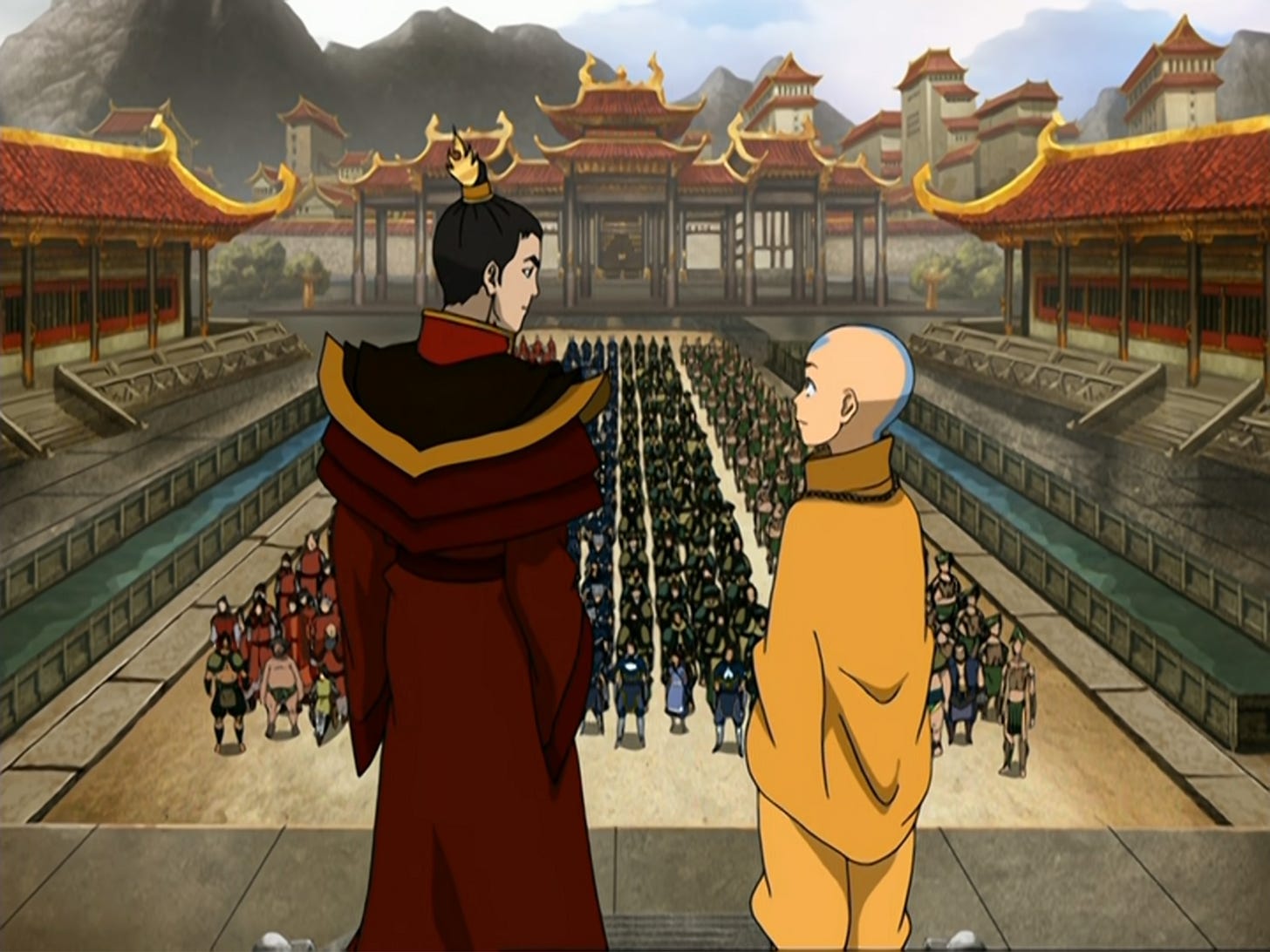Thanks for tuning in to my very last of 61 daily reviews of Avatar: The Last Airbender! I truly cannot believe we’re finally at the finish line. Exactly 61 days ago, I had an ambitious, impulsive idea, and frankly I had no clue what I was getting into. But it’s been such a fun journey and I really appreciate everyone who’s offered a kind word — you really helped keep me going. Sometime soon I’ll do a recap of some of my takeaways and tally up the word count.
As a warning, this review is my longest yet. It covers Part 3: Into The Inferno and Part 4: The Old Masters. Yesterday, we watched S3E18 / S3E19: Sozin’s Comet Pts 1 & 2.
Colored by the beautiful, dusky red palette of Sozin’s comet, Avatar’s final chapters follow four parallel stories as the resistance against the Fire Nation makes its dramatic final stand. These are not subtle episodes, full of character development and quietly meaningful moments. The time for that has passed. Today is the day for full-throated, white-knuckled action.
The first of these stories is the White Lotus’ battle to recapture Ba Sing Se. General Iroh begins their assault on the great city with an immense ball of fire that shatters the Inner Wall to smithereens. The comet’s aura has bestowed unparalleled power on the firebenders, and their newfound might is palpable. Jeong Jeong destroys the advancing tanks with an unbelievable wall of fire, while he creates flame jets to fly above the battlefield.
While the old masters overwhelm the Fire Nation’s defenses, Iroh is missing from the fray. He has a more symbolic mission in mind. Standing at the palace gates, Iroh ignites the Fire Nation banner hanging above to reveal the emblem of Earth Kingdom beneath.
The second plotline follows Sokka, Suki, and Toph as they attempt to stop the Fire Nation’s armada of airships. From above, Ozai’s firebenders rain down an inferno of unrelenting fire onto the land, instantly torching the forest below and any unfortunate life within it. The trio manages to hijack an airship for themselves, but faced by the enormity of their challenge, Sokka madly proposes a desperate plan to ram the armada with the only aerial weapon they have: their own ship.
Their insane gambit is riveting to watch. Each of our characters heroic traits — Sokka’s bravery, intelligence, and leadership; Toph’s raw power and decisiveness; Suki’s, uh… dependability — are on full display. And the plan works, sending most of the airships careening down. But victory comes at a great price.
As their airship breaks apart beneath them, Sokka and Toph are separated from Suki, and they fall off the side of the ship. Sokka lands painfully on a platform and barely manages to grab Toph from falling to her death. But a squad of firebenders come to finish them off, and even the sacrifice of Sokka’s beloved boomerang and space sword isn’t enough to save the duo.
For most of the series, there was never any fear that any core members of Team Avatar would die, protected by their plot armor. But here, in the finale, with the stakes so large, it feels like all bets are off. Would Avatar sacrifice one of the characters we love so much in these final moments? A haunting score plays and the scene lingers on Toph, crying, as she and Sokka steel themselves for their fate.
But perhaps we shouldn’t get too carried away, since this is still a kids’ show (even the two firebenders Sokka knocks off the platform don’t fall, since they’re suspended by ropes). Sokka and Toph are saved by the return of Suki, piloting yet another hijacked airship.
The third story, the one with the most emotional weight behind it, follows Zuko and Katara as they confront Azula, who at this point has become just as familiar and compelling of a character as any one of our protagonists. It’s the day of her coronation as Fire Lord, and for the first time, it’s well and truly clear that something is going very wrong with the princess.
After Mai and Ty Lee’s betrayal in The Boiling Rock, Azula is spiraling into paranoia. She has lost confidence in her ability to control her underlings through fear. She banishes her servants, her royal guards, her Dai Li agents, and even her advisors Lo and Li, anxious that they are plotting to undermine or overthrow her. She’s left all by herself, dwelling on all the people who have abandoned her: her mother, her brother, her friends. Even her father leaves her in The Phoenix King to Go-Go-Gadget Genocide on his own as she protests pitifully.
You… you can't treat me like this! You can't treat me like Zuko!
Azula is defined by her relationships with her parents, a specter that hangs over her. Most influential is her relationship with her father, who weaponized her and taught her to do the same to others. He reinforced in her that fear is the means to power, that only perfection is acceptable, and that failure demands severe punishment. In one of our first moments with her character, in The Avatar State, she grows angry with herself while training for having “one hair out of place.”
But alone in her chambers, Azula cuts herself mental breakdown bangs (she’s! fine!), and it’s not her father but her mother, Ursa, whom she hallucinates. In The Beach, she lamented that “my own mother thought I was a monster.” Azula is not a reliable narrator, so we can’t necessarily trust her interpretation, but those feelings are real. Now, she imagines a mother who is unshaken by Azula’s fearsome behavior and stands by her daughter with a relentless, unconditional love. How might she have turned out differently if she’d had someone like that, a positive mentor like Iroh was to Zuko? We’ll never know the answer. Neither will Azula, now weeping, beyond redemption.
In her final Agni Kai with Zuko, with the crown at stake, Zuko can tell that his sister is “slipping.” She moves like a twisted marionette, with halting, jerky motions. And for the first time, he’s truly getting the better of her, standing his ground and blocking all her attacks while she circles him. Unlike Aang’s frantic, tense battle with Ozai, the Last Agni Kai is sentimental, almost poetic, scored with a melancholy string arrangement. The images of clashing blue and orange fire are strikingly beautiful. There’s no epic showdown here, just a sad tale of two siblings turned against each other by their father.
Azula infamously spoils the duel, firing a dishonorable lightning bolt at Katara on the sidelines. Zuko proves that his metamorphosis is complete as he sacrifices himself for her, a selfless act he would have done for anyone on Team Avatar. Azula’s strike is the final chapter in a long history of suffering inflicted by the Fire Nation, and the prince is willing to step up and do whatever it takes to restore the honor of his nation. Miraculously, he survives.
With the massive power of Sozin’s comet, Katara is no match for Azula head-on. But in the thrilling resolution to their story, Katara outwits the crazed princess, luring her to a storm drain and freezing them both. After she chains Azula’s wrists, subduing her for good, the princess snaps, sobbing and flailing as she fruitlessly spits fire. There’s no joy in victory for Katara and Zuko, only sadness, as they watch her distressing demise. It’s a poignant sendoff for one of the most charismatic and terrifying animated villains ever.
And at last, it’s time for the final chapter. The grand battle we’ve been waiting three seasons for, a battle that’s been fated since Fire Lord Sozin left Avatar Roku to die a century ago.
Aang’s fight with Ozai eschews many elements of a typical Avatar battle — martial arts inspired choreography with tit-for-tat, close-quarters combat — for an epic clash of flying and fire-blasting that wouldn’t feel out of place in Dragon Ball. It’s actually the only time we’ve seen Aang fight in Season 3, outside of his brief attempt to catch Azula in The Day of Black Sun. It’s astounding how much more powerful he’s become, bending massive columns of stone and kicking an immense wave of fire.
But it’s not enough. The Fire Lord’s bending is too strong, and with his incredible comet-enhanced flight, he’s too fast for the Avatar. Aang spends most of the battle on the defensive, running and shielding himself as the two fighters bounce around the remarkable forest of stone pillars. He gets one decisive opportunity to defeat Ozai, as he uses Iroh’s technique to redirect the shocked Fire Lord’s deadly lightning. But staying true to his pacifist ideals, he lets the opportunity slip away, firing into the air instead of back at his opponent.
Ultimately, Aang is able to win the fight on his own terms thanks to two dei ex machina, surprising and unlikely events that have been the source of much discussion and controversy for fans. The first of these, allowing him to overpower Ozai, is his reclamation of the Avatar State. As Ozai sends Aang careening with a bone-chilling torrent of fire, the Avatar hits his back precisely where Azula had shot him with lightning and locked his chakra. The tide is instantly turned in Aang’s favor, as he surrounds himself with a ball of all four elements, chasing the Fire Lord who now flees in terror.
The second surprise reveals what Aang learned from the lion turtle: the ability to bend someone’s own energy. In the final climax of the fight, Aang stops his own past lives from killing Ozai, and bends his energy instead to take away the Fire Lord’s bending for good. The energybending scene is played up for maximum drama as Ozai’s spirit threatens to corrupt and destroy Aang.
Make no mistake, these moments are the writers plotting themselves out of a corner. Aang is a twelve-year-old boy who hasn’t mastered all four elements yet, and it would feel unearned for him to come into the fight stronger than Ozai. But Aang’s destiny is his alone, and the show needed a way for him to defeat the Fire Lord on his own. And it needed a way for Aang to do it without taking his life.
Yes, Avatar could have done it differently. The dilemma between duty and nonviolence is a real one, and there’s not always such an easy out. We could have gotten a more realistic ending, with the same tough lesson that Aang’s past lives gave him: duty requires moral sacrifice. But not only would that not be true to Aang, it wouldn’t be true to Avatar, which is a fundamentally idealistic show, not a work of gritty realism. It’s animated TV — a medium where anything is possible, one that dares us to dream bigger than the cold confines of our lives. Don’t compromise your deepest-held values; if you are persistent, an answer will come.
As the sun sets on this beloved saga, Aang and Zuko take a moment to look back on how far we’ve come. They began as bitter enemies, but since The Blue Spirit, Aang always knew they could be friends. And now they are. In many ways, Avatar is the story of the Avatar and the Fire Lord, of a century-old feud finally righted. With his coronation as Fire Lord, Zuko proudly declares his vision to restore balance to the world.
I promised my uncle that I would restore the honor of the Fire Nation. And I will. The road ahead of us is challenging. A hundred years of fighting has left the world scarred and divided. But with the Avatar's help, we can get it back on the right path and begin a new era of love and peace.
Just like Aang, Sozin’s Comet carries the weight of a franchise on its shoulders. And all the love that was clearly poured into this finale shines brightly through, with a deeply affecting score and magnificent animation that rivals the best chapters in the series. Even with everything it needs to get through, it’s an exhilarating, moving resolution that sticks the landing and does right by the show that has meant so much to so many.
When Avatar premiered in 2005 as another children’s program on Nickelodeon, nobody could have predicted the powerful emotions it would stir within us; the brave, flawed, compelling characters who would grow over time, as we did; the riveting action that would keep us glued to our seats; the profound wisdom that we would treasure for years to come. And as it does in the final scene, Avatar never forgets to pay tribute to the strong friendships and that lighthearted sense of joy that makes this story so special.
Thanks for reading, and for joining me on this crazy ride! I would love to hear your own thoughts on this episode or the series as a whole in the comments.
Spare observations
The setting of Aang’s battle is inspired by the rock formations of a real forest in China, which also inspired areas from the unrelated movie Avatar (with the blue people).
“I won’t have my first day as Fire Lord marred by poor foot hygiene.”
“I can't believe the captain remembered my birthday! He really does care!”
Toph warns Sokka to jump when they’re about to crash into another ship. But she shouldn’t be able to see it!
“Have I ever mentioned how sweet it is that you invented metalbending?” “You could stand to mention it more.”
“My leg!” Sokka cries. Bro, what about that hyperextended shoulder?
“I don't think boomerang's coming back, Toph.” 😔
Aang finally masters the Avatar State at the end, entering it briefly at will to pull in the tides, washing away all the fire. It’s another nod to the motif of the biblical Flood.
Even as it ends, Avatar leaves us with a cliffhanger as Zuko confronts Ozai. “Where is my mother?” If you want to know, read The Search!
Lots of reunions and wrapping up of loose threads. Mai and Zuko reunite; so do Sokka, Katara, and their father; even Ty Lee gets a happy ending and joins the Kyoshi Warriors.
The final scene takes place in Iroh’s tea shop in Ba Sing Se, The Jasmine Dragon.
In happily-ever-after tradition, Aang gets the girl in the end. It helps when you’re the Avatar.














